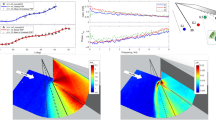Abstract
Fin-generated swept shock wave/turbulent boundary layer interactions were experimentally investigated via nanoparticle-based planar laser scattering method, surface oil flow visualizations, surface pressure measurements, and particle image velocimetry. Surface plateau pressure is also theoretically predicted. The plateau pressure of present quasi-conical swept shock interaction is dependent on the local skin friction coefficient and normal Mach number component, and can be predicted per a criterion deduced from free interaction theory. Visualizations and surface pressure measurements confirm that the surface plateau pressure data are equal to the pressure downstream of the separation shock; the upstream influence line is parallel to the impingement line of the separation shock on the flat plate. These observations support the free interaction theory as-applied to quasi-conical swept shock interactions.
Graphical abstract











Similar content being viewed by others
References
Alvi FS, Settles GS (1990) Structure of swept shock wave/boundary-layer interactions using conical shadowgraphy. AIAA Paper 90-1644
Alvi FS, Settles GS (1991) A physical model of the swept shock wave/boundary-layer interaction flowfield. AIAA Paper 91-1768
Babinsky H, Harvey JK (2011) Shock wave–boundary-layer interactions. Cambridge Press, Cambridge
Chapman DR, Kuehn DM, Larson HK (1958) Investigation of separated flows in supersonic and subsonic streams with emphasis on the effect of transition. NACA Rept. 1356
Charwat AF (1970) Supersonic flows with imbedded separated regions. Adv Heat Transf 6:1–132
Coles D (1953) Measurements in the boundary layer on a smooth flat plate in supersonic flow. Ph.D. Thesis, California institute of technology, California
Deng XY, Liao JH (1991) Correlative behaviours of shock/boundary layer interaction induced by sharp fin and semicone. AIAA Paper 91-1756
Deng XY, Liao JH, Zhang H (1993) Improvement of conical similarity rule in swept shock wave/boundary layer interaction. AIAA Paper 93-2941
Gang DD, Yi SH, He L (2016) Characteristics of the cylinder-induced shock wave and turbulent boundary layer interactions. J Vis 19:581–585
Guarini SE, Moser RD, Shariff K, Wray A (2000) Direct numerical simulation of a supersonic turbulent boundary layer at Mach 2.5. J Fluid Mech 414:1–33
Hayes JR (1977) Prediction techniques for the characteristics of fin generated three dimensional shock waves turbulent boundary layer interactions. AFFDL-TR-77-10
Lu FK (1993) Quasiconical free interaction between a swept shock and a turbulent boundary layer. AIAA J 31(4):686–692
Lu FS, Settles GS, Horstman CC (1990) Mach number effects on conical surface features of swept shock-wave/boundary-layer interactions. AIAA J 28(1):91–97
Schülein E, Zheltovodov AA (2001) Documentation of experimental data for hypersonic 3-D shock waves/turbulent boundary layer interaction flows. DLR report. IB 223-99 A 26
Settles GS, Lu FK (1985) Conical similarity of shock/boundary-layer interactions generated by swept and unswept fins. AIAA J 23(7):1021–1027
Settles GS, Kimmel RL (1986) Similarity of quasiconical shock wave/turbulent boundary-layer interactions. AIAA J 24(1):47–53
Tao Y, Liu WD, Fan XQ (2016) Flow visualization for shock-induced boundary-layer separation extended to the flat-plate-leading edge. J Vis 20:231–235. https://doi.org/10.1007/s12650-016-0393-3
Van Oudheusden BW, Nebbeling C, Bannink WJ (1996) Topological interpretation of the surface flow visualization of conical viscous/inviscid interactions. J Fluid Mech 316:115–137
Wang ZG, Zhao YL, Zhao YX, Fan XQ (2015) Prediction of massive separation of unstarted inlet via free-interaction theory. AIAA J 53:1108–1111
Zhao YL (2014) The study of separated flow modeling and unstart mechanism of hypersonic inlet. Ph.D. Thesis, National University of Defense Technology, China
Zhao YX, Yi SH, Tian LF, Cheng ZY (2009) Supersonic flow imaging via nanoparticles. Sci Chi Ser E 52:3640–3648
Zheltovodov AA (1996) Shock waves/turbulent boundary-layer interactions- fundamental studies and applications. AIAA Paper 96-1977
Zukoski EE (1967) Turbulent boundary-layer separation in front of a forward-facing step. AIAA J 5(10):1746–1753
Acknowledgements
This work was supported by the National Natural Science Foundation of China (Grant No. 11472304).
Author information
Authors and Affiliations
Corresponding author
Rights and permissions
About this article
Cite this article
He, G., Zhou, J. & Zhao, Yx. Application of free interaction theory in swept shock wave/turbulent boundary layer interactions. J Vis 21, 203–214 (2018). https://doi.org/10.1007/s12650-017-0454-2
Received:
Revised:
Accepted:
Published:
Issue Date:
DOI: https://doi.org/10.1007/s12650-017-0454-2




